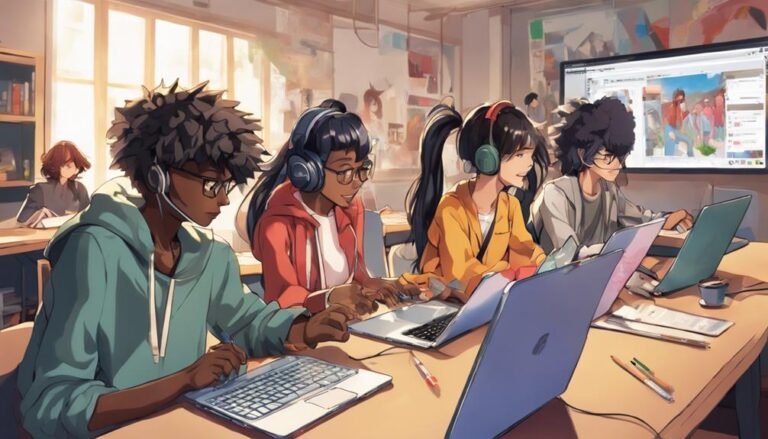How Do I Create Effective Online Tutorials for Technical Skills Development?
To create effective online tutorials for developing technical skills, first, understand your learners' needs and cater to their preferences. Design interactive content with clear objectives, engaging activities, and multimedia elements to keep learners interested. Structure your tutorials logically, starting from basics to advanced topics, and use visual aids for better comprehension. Choose tools that support interactivity, multimedia, and easy navigation. Incorporate real-world examples, quizzes, and practical exercises to enhance engagement. By implementing these strategies, you can create dynamic tutorials that effectively boost technical skill development. And remember, the next steps will help you dive deeper into the process.
Key Takeaways
- Understand learner needs and preferences for tailored tutorials.
- Plan tutorial structure with clear objectives and engaging visual aids.
- Choose tools with multimedia support and user-friendly interfaces.
- Create interactive content with real-world examples and simulations.
- Incorporate assessments aligned with learning objectives for continuous improvement.
Understanding Learner Needs
To create effective online tutorials for technical skills development, you must first understand the specific needs and preferences of the learners. When focusing on learner engagement, instructional design plays an important role. Learner engagement refers to the level of involvement, interaction, and interest that learners have during the tutorial. It's essential to design tutorials in a way that captures and maintains the learners' attention throughout the learning process.
In instructional design, elements such as clear learning objectives, interactive activities, and multimedia content can greatly impact learner engagement. Understanding the diverse learning styles and preferences of your audience is key to creating tutorials that resonate with them. By incorporating interactive quizzes, practical exercises, and real-world examples, you can enhance learner engagement and make sure that the information is effectively conveyed.
Effective instructional design not only focuses on delivering the content but also on creating a seamless learning experience that caters to the needs and preferences of the learners. By prioritizing learner engagement through thoughtful instructional design, you can create online tutorials that are both informative and engaging.
Planning Tutorial Structure
Understanding learner needs is the foundation upon which you can effectively structure your online tutorials for technical skills development. When planning the structure of your tutorials, consider the importance of time management. Break down the content into manageable sections to prevent overwhelming your learners. Clearly outline the objectives at the beginning of each tutorial to help learners understand what they'll achieve by the end.
Important aids play a vital role in enhancing the effectiveness of your tutorials. Incorporating diagrams, charts, and videos can help reinforce concepts and make learning more engaging. Visual aids can also simplify complex topics, making them easier for learners to grasp.
To ensure efficient time management, organize your tutorial content in a logical sequence. Start with the basics before progressing to more advanced topics. This gradual progression allows learners to build upon their knowledge systematically. Additionally, use visual aids strategically to aid in retention and understanding. By structuring your tutorials thoughtfully and incorporating visual aids effectively, you can create a more engaging and impactful learning experience for your audience.
Choosing the Right Tools
When creating online tutorials, selecting the right tools is essential. Consider tips for choosing tools, the importance of software compatibility, and ensuring a user-friendly interface.
These factors will play a significant role in the effectiveness of your technical skills development tutorials.
Tool Selection Tips
Selecting the right tools is essential for creating effective online tutorials for technical skills development. When comparing tools, conduct a thorough feature analysis to make sure they meet your tutorial requirements.
Consider tools that offer seamless platform integration and customization options, allowing you to tailor tutorials to your audience's needs. Look for user-friendly interfaces that enhance the learning experience.
Prioritize tools that support multimedia elements and interactive features to engage learners effectively. By choosing tools that align with your tutorial goals and audience preferences, you can create engaging and impactful online tutorials for technical skills development.
Software Compatibility Considerations
Consider the technical specifications of your software and the compatibility requirements when choosing the right tools for creating effective online tutorials. Verify your software meets the necessary hardware requirements and stays updated to leverage the latest features. Check system configurations to guarantee smooth operation and peak performance.
It's important to assess device compatibility to reach a broader audience without technical hiccups. By staying on top of software updates and hardware requirements, you can create tutorials that cater to a wide range of users. Paying attention to system configurations and device compatibility will help you deliver a seamless learning experience for your audience.
User-Friendly Interface Importance
Choosing tools with a user-friendly interface is vital for creating engaging and effective online tutorials for technical skills development. User engagement is key, and a visually appealing design can greatly enhance the learning experience.
When selecting tools, prioritize those that offer intuitive navigation, clear instructions, and interactive elements to keep learners interested and motivated. A clutter-free layout and straightforward functionalities contribute to a seamless learning process, allowing users to focus on acquiring new skills without being distracted by complicated interfaces.
Creating Engaging Content
To create engaging online tutorials for technical skills, aim to use interactive multimedia elements that captivate your audience.
Real-world examples can help learners relate theory to practice, making the content more relevant and interesting.
Encouraging active participation through quizzes, exercises, or simulations can boost engagement and reinforce learning.
Use Interactive Multimedia
Enhance your online tutorials by incorporating interactive multimedia elements that captivate your audience and facilitate effective learning experiences. Utilize interactive simulations to provide hands-on practice and reinforce learning. Integrate multimedia elements such as videos, animations, and infographics to enhance visual engagement and aid comprehension. By incorporating these interactive multimedia components, you can create a dynamic learning environment that keeps learners engaged and motivated throughout the tutorial. Interactive simulations allow users to apply theoretical knowledge in practical scenarios, promoting better retention and understanding of technical skills. This multimedia integration not only makes the learning process more interactive but also caters to different learning styles, ensuring a more comprehensive learning experience for your audience.
| Interactive Simulations | Multimedia Integration |
|---|---|
| Hands-on Practice | Visual Engagement |
| Practical Scenarios | Videos |
| Application of Knowledge | Animations |
| Better Retention | Infographics |
Include Real-World Examples
Injecting real-world scenarios into tutorials is a powerful way to engage learners and enhance their understanding of technical skills. By incorporating practical examples, you illustrate how these skills are applied in professional settings. This approach encourages hands-on practice through challenges that simulate real work situations. For instance, in coding tutorials, learners can tackle projects resembling tasks found in actual jobs. Not only does this make learning interactive, but it also highlights the practical relevance and impact of the skills being learned.
Real-world examples bring depth and context to tutorials, enriching the learning experience and making it more effective. They help learners connect theory to practice, fostering a deeper understanding and appreciation for the subject matter. Ultimately, integrating real-world scenarios into tutorials creates a dynamic and engaging learning environment that resonates with learners and equips them with valuable skills for their future endeavors.
Encourage Active Participation
Engage learners actively by creating content that captivates their attention and encourages hands-on participation in the learning process. To promote active engagement and learner motivation, incorporate hands-on practice and opportunities for group collaboration in your online tutorials. Encouraging learners to apply theoretical knowledge through practical tasks not only reinforces understanding but also boosts their confidence in applying new skills.
Consider integrating interactive elements like quizzes, simulations, or virtual labs to make the learning experience more engaging and dynamic. Group projects or discussions can foster a sense of community and shared learning experience among participants. By fostering active participation, you can create a more immersive and effective online tutorial that resonates with learners and enhances their technical skills development.
Incorporating Interactive Elements
To improve the effectiveness of your online tutorials for technical skills development, consider integrating interactive elements that actively involve learners in the learning process. Interactive exercises allow learners to apply concepts in a practical setting, reinforcing their understanding. Feedback loops provide immediate responses to learner actions, enhancing engagement and facilitating continuous improvement.
Here are some tips for incorporating interactive elements:
- Quizzes and assessments: Include interactive quizzes to test knowledge and reinforce learning.
- Simulations and virtual labs: Offer hands-on experience in a risk-free environment.
- Drag-and-drop activities: Engage learners in interactive tasks that require them to apply concepts.
- Branching scenarios: Create decision-making scenarios where learners choose different paths based on their choices.
- Collaborative projects: Encourage teamwork and communication through group assignments.
Implementing Effective Assessments
When designing assessments for your online tutorials, prioritize creating tasks that accurately measure learners' understanding and skill proficiency. Effective assessment strategies are vital for evaluating the effectiveness of your technical skills tutorials. Incorporating various evaluation methods such as quizzes, practical assignments, and project submissions can help gauge learners' comprehension and application of the material.
In test design, consider aligning assessment tasks with the learning objectives to make sure that they directly assess the intended skills. Clearly outline the criteria for grading and provide detailed grading rubrics to offer transparency to learners on how their work will be evaluated. This clarity not only helps learners understand expectations but also guides them on how to improve their performance.
Promoting Continuous Learning
To foster continuous growth and development in technical skills, it's important to cultivate a culture of ongoing learning and improvement among learners. Continuous learning can be promoted effectively by implementing various strategies that keep learners engaged and motivated.
Here are some key approaches to promote continuous learning:
- Gamification benefits: Incorporating game-like elements such as points, badges, and leaderboards can make learning more interactive and enjoyable.
- Engagement strategies: Using interactive quizzes, discussions, and real-world projects can enhance engagement levels and encourage active participation.
- Microlearning advantages: Breaking down lessons into smaller, bite-sized chunks can help learners absorb information more effectively and retain knowledge for longer periods.
- Personalized learning: Tailoring tutorials to individual learning styles and preferences can boost motivation and improve overall learning outcomes.
- Feedback mechanisms: Providing regular feedback on progress and performance can help learners track their development and identify areas for improvement.
Conclusion
In summary, developing effective online tutorials for technical skills enhancement is vital for engaging learners and promoting continuous learning.
Did you know that 88% of employees believe they don't have the skills needed for their current job? By offering high-quality tutorials, you can help bridge this skills gap and empower individuals to succeed in their careers.
Remember to always consider learner needs, plan carefully, and incorporate interactive elements for a truly impactful learning experience.







